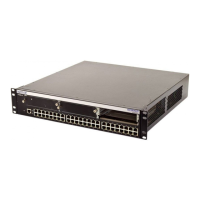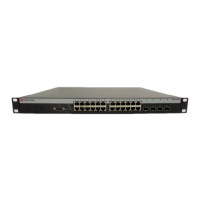Making Network Connections
4-6
4
100 Mbps Fast Ethernet Collision Domain
10 Mbps Ethernet Collision Domain
Cable Labeling and Connection Records
When planning a network installation, it is essential to label the opposing ends of
cables and to record where each cable is connected. Doing so will enable you to
easily locate inter-connected devices, isolate faults and change your topology
without need for unnecessary time consumption.
To best manage the physical implementations of your network, follow these
guidelines:
• Clearly label the opposing ends of each cable.
• Using your building’s floor plans, draw a map of the location of all
network-connected equipment. For each piece of equipment, identify the devices
to which it is connected.
• Note the length of each cable and the maximum cable length supported by the
switch ports.
Table 4-3. Maximum 1000BASE-LX Gigabit Ethernet Cable Length
Fiber Size Fiber Bandwidth Maximum Cable Length Connector
9/125 micron
single-mode fiber
N/A 2 m - 5 km (7 ft - 3.2 miles) LC
Table 4-4. Maximum 1000BASE-LH Gigabit Ethernet Cable Length
Fiber Size Fiber Bandwidth Maximum Cable Length Connector
9/125 micron
single-mode fiber
N/A 2 m - 70 km (7 ft - 43.5 miles) LC
Table 4-5. Maximum Fast Ethernet Cable Lengths
Type Cable Type Max. Cable Length Connector
100BASE-TX Category 5 or better 100-ohm UTP or STP 100 m (328 ft) RJ-45
100BASE-FX
Multimode
50/125 or 62.5/125 micron core multimode
fiber (MMF)
2 km (1.24 miles) SC
100BASE-FX
Single-mode
9/125 micron core single-mode fiber (SMF) 20 km (12.43 miles) SC
Table 4-6. Maximum Ethernet Cable Length
Cable Type Maximum Length Connector
Twisted Pair, Category 3 or better 100-ohm UTP 100 m (328 ft) RJ-45

